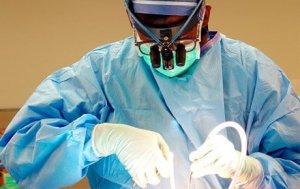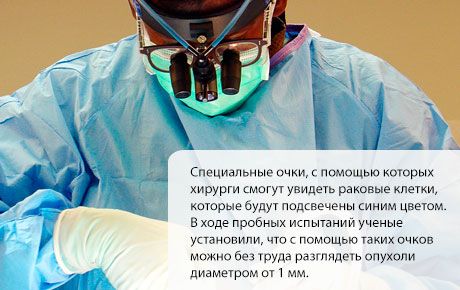
All iLive content is medically reviewed or fact checked to ensure as much factual accuracy as possible.
We have strict sourcing guidelines and only link to reputable media sites, academic research institutions and, whenever possible, medically peer reviewed studies. Note that the numbers in parentheses ([1], [2], etc.) are clickable links to these studies.
If you feel that any of our content is inaccurate, out-of-date, or otherwise questionable, please select it and press Ctrl + Enter.
Special glasses will help oncosurgeons remove all pathological cells without affecting healthy cells
Last reviewed: 01.07.2025
 ">
">When performing operations to remove malignant tumors, every surgeon faces a rather difficult task: separating pathological cells from healthy ones. In order to increase the efficiency of such situations and facilitate the work of specialists, a research group from Washington has developed a special device.

A group of scientists has created special glasses that will allow surgeons to see cancer cells that will be illuminated in blue. During trial tests, scientists have found that with the help of such glasses, it is easy to see tumors with a diameter of 1 mm. In order for the device to highlight pathological cells in blue, the developers have proposed using a special dye approved by the Food and Drug Administration in the United States. This dye must be injected into the affected area before surgery.
The small device is battery-powered, wireless, and leaves the surgeon's hands free. The glasses are based on a night vision device, and can operate in both infrared and normal light. The visual data received is transmitted to a special eyepiece that can be adjusted. Thanks to wireless communication, the device transmits a picture in real time to a computer, and as a result, all the surgeon's actions are displayed on the monitor. This will allow other specialists to observe what is happening in the operating room and, if necessary, provide advice.
The new development uses an improved eyepiece that is used for intraoperative imaging. Such systems are quite expensive, complex and time-consuming, and the radiation from the device affects both the patient and the surgeon. Special blue dyes that are used to identify abnormal cells can also cause adverse reactions.
Special glasses for oncosurgeons were developed by a scientific group headed by Samuel Aquilfu (employee of the University School of Medicine in St. Louis, doctor of bioengineering and radiology). In early February, the first operation using the new device was performed, which was conducted by Julia Margenthaler, associate professor of the university and thoracic surgeon.
Currently, surgeons almost always affect adjacent healthy cells during tumor removal operations. After the operation, the removed healthy cells are analyzed, and if they have an initial stage of damage, the patient requires a repeat operation to remove the tissue, which is also analyzed in the laboratory. In breast tumors, a repeat operation is required in 25% of cases. The new device will allow surgeons to see all the affected cells, which will avoid a repeat operation, since the surgeon will be able to remove all the unhealthy cells during the first operation.
There are currently several trial samples that have already been used in some operations.

 [
[